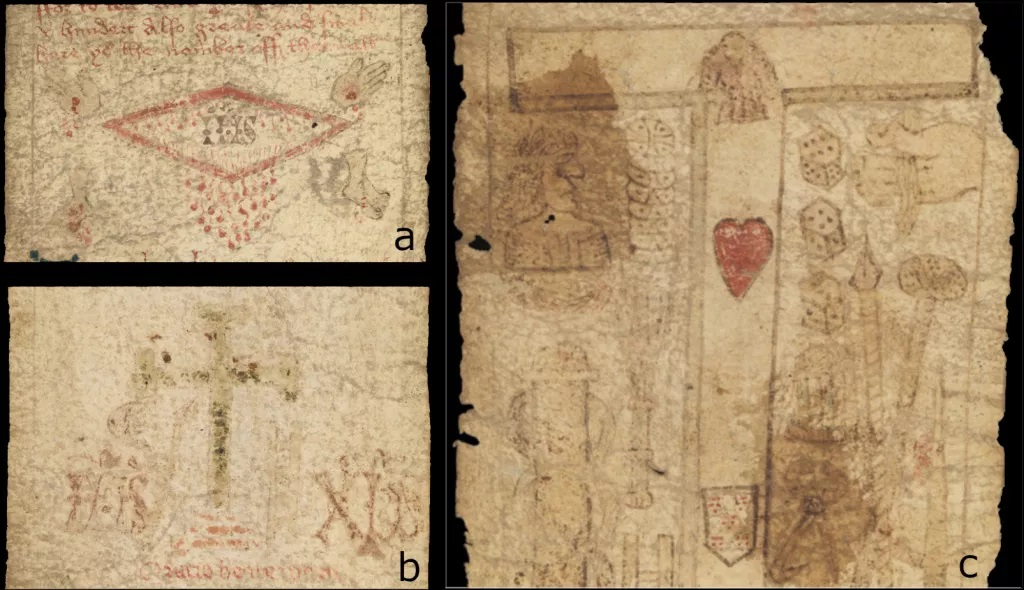
The medieval birthing scroll has illustrations from Christian imagery to protect a woman from the dangers of childbirth, including the wound on the side of the crucified Christ, dripping blood (upper left); a rubbed-away crucifix and holy monograms (lower left); and a tau (headless) cross adorned with a sacred heart and shield, alongside a standing figure that may be Jesus. (Image credit: Wellcome Collection, CC-BY 4.0)
A rare strip of parchment more than 10 feet (3 meters) long and adorned with Christian emblems shows chemical traces of its use by women in medieval England as a magical amulet to protect them during pregnancy and childbirth, according to a new study.
On the surface of the strip of parchment — called a “birthing girdle” or “birth scroll” — the researchers found traces of plant and animal proteins from medieval treatments used to treat common health problems during pregnancy, and of human proteins that match cervico-vaginal fluid. Those traces suggest the girdle was worn by women while they gave birth.
“This particular girdle shows visual evidence of having been heavily handled, as much of the image and text have been worn away,” biochemist Sarah Fiddyment of the archaeology department at the University of Cambridge told Live Science in an email. “It also has numerous stains and blemishes, giving the overall appearance of a document that has been actively used.”
Fiddyment is the lead author of the new study, which was published on Tuesday (March 9) in the journal Royal Society Open Science.
The long and narrow parchment was originally made, probably in the late 15th century, from four strips of sheepskin that had been scraped thin and stitched together. The resulting strip is illustrated with Christian imagery, including pictures of the nails of the crucifixion; the holy monogram IHS, which is a way of writing Jesus’ name; a standing figure, possibly Jesus; and his crucifixion wounds, dripping with blood. The text of Christian prayers also appears on both sides.
Birthing girdles
The birthing girdle described in the study is a rare surviving example held in the Wellcome Collection, a museum and library of science, medicine, life and art in London.
Such girdles were once commonplace as magical remedies to protect women from the dangers of childbirth, which was a leading cause of death for women in the medieval period.
There are several references to their use in medieval England, and churches and monasteries often loaned them out to pregnant women in return for a donation; when the wife of the English king Henry VII became pregnant, the sum of six shillings and eight pence was paid “to a monke that brought our Lady gyrdelle to the Queen,” according to historic records.
Women would wear the scrolls of illustrated parchment or silk wrapped around their waist and pregnancy bump in one of several configurations; the scrolls were about 4 inches (10 centimeters) wide and just about exactly 11 feet (3.3 m) long — it was thought that such a girdle would fit Mary, the mother of Jesus.
But birthing scrolls and other church rituals were targeted for destruction during Henry VIII’s so-called “Dissolution of the Monasteries” that began in 1536. Protestant reformers considered the rituals of childbirth as “sanctuaries for forbidden religious practices,” and they actively tried to suppress them — although recalcitrant midwives continued to use birthing girdles on the sly, wrote the researchers.
“One of the great anxieties of the Reformation was the adding of aid from supernatural sources beyond the Trinity,” study co-author Natalie Goodison, a historian at the universities of Durham and Edinburgh, explained in an email. “The birth girdle itself seems to have been particularly worrisome, because it seems to harness both ritualistic and religious powers.”

